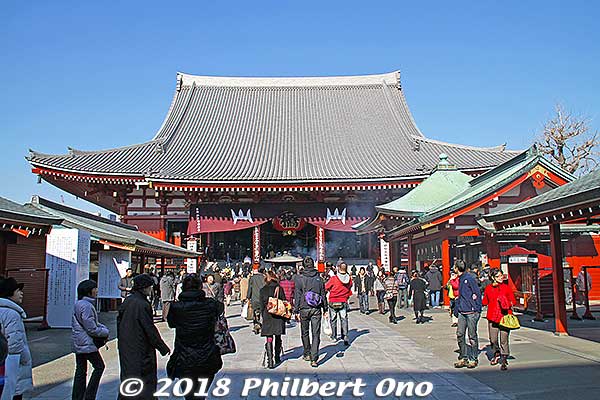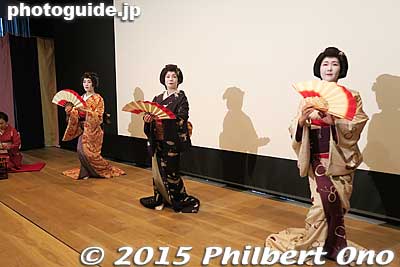
“If you don’t visit Asakusa, you haven’t seen Tokyo” is what I always tell my tourist friends visiting Tokyo, even those who don’t like crowds or tourist traps. Amid this megacity’s modernity, Asakusa is an oasis of Tokyo’s “old town.” Asakusa’s fame and popularity is owed to Sensoji Temple (浅草寺), Tokyo’s most famous and popular Buddhist temple also called “Asakusa Kannon Temple.”

The iconic symbol of Sensoji Temple and Asakusa is Kaminarimon Gate or “Thunder Gate,” the temple’s main gate with a giant red paper lantern. It is one of Japan’s most photographed buildings and a prime spot for “I’m in Tokyo” selfies. Both the gate (rebuilt in 1960) and giant paper lantern were donated by a major Japanese electronics company (Matsushita aka Panasonic). The giant paper lantern can be collapsed from the bottom up to make way for portable shrines, etc., passing through.



Right after Thunder Gate is the Nakamise-dori path (仲見世通り) of touristy souvenir shops leading to Sensoji Temple. They sell just about all the Japanese trinkets you can imagine, including T-shirts, kimono (yukata), and happi coats. Lots of edible things too, like chestnuts and fried manju.
Nakamise ends with Hozomon Gate (宝蔵門) housing another large paper lantern and a pair of Nio guardians protecting the temple. Hozomon Gate (“Treasure Storage Gate”) was reconstructed in 1964 with ferroconcrete. The second floor houses Important Cultural Properties (not open to the public). The back of the gate has a pair of giant straw sandals to scare away evil spirits fearful of the giant guardian the sandals belong to.


After Hozomon Gate is the heart of Sensoji Temple (and Asakusa) with the picturesque five-story pagoda and Hondo main hall. Before entering the main hall, you may want to catch some smoke from the incense burner. Worshippers scoop the smoke to the parts of their bodies they want to heal. Students studying for entrance exams might fan some smoke to their heads.


The main hall has a traditional design, but it was rebuilt in 1958 with ferroconcrete after the previous building from the 17th century was destroyed during World War II. Sensoji’s main hall has been destroyed (by fire, lightning, earthquakes, war, etc.) and rebuilt almost 20 times throughout the centuries. It is Sensoji’s largest building and similar in design to the previous Hondo built in 1649. Inside is a large altar for Kannon (kept hidden), popularly called the “Goddess of Mercy.” It is actually a benevolent, female Bodhisattva. Sensoji used to belong to the Tendai Buddhist sect, but it is now an independent Buddhist temple and sect.


The five-story pagoda was reconstructed in 1973 with ferroconcrete. The top floor stores some ashes of the Buddha brought from a temple in Sri Lanka in 1966. Its corroding aluminum roof tiles were replaced with titanium tiles in 2017.
According to legend, in 628, two fishermen brothers, Hamanari and Takenari Hinokuma, found a golden Kannon buddha statue while fishing in Sumida River. Their mentor Hajinoma Nakatomo recognized the statue’s religious significance, became a monk, and converted his home into a small temple for the statue. This temple eventually grew to become Sensoji, and Asakusa also developed and prospered. Considered to be the founders of Asakusa, these three men have been deified by Asakusa Shrine (adjacent to Sensoji Temple) and honored annually by the Sanja Matsuri in May, one of Tokyo’s biggest festivals.

Sensoji’s main hall, pagoda, and Hozomon Gate have been recently reroofed with titanium roof tiles instead of traditional clay tiles. Since the titanium roof tiles can be painted to look like traditional roof tiles, you can’t tell the difference. Titanium roof tiles are much more expensive than clay tiles, but they are much cheaper to maintain due to their high strength, durability, and corrosion resistance to acid rain and salt air. Titanium tiles are also much lighter and smaller than clay tiles to make the building much less top heavy. Top-heavy, Japanese-style buildings are more prone to collapse in a major earthquake.
Sensoji and Asakusa hold numerous festivals and events throughout the year. During New Year’s, the temple is crowded with worshippers praying for a prosperous and safe year. On Feb. 3, there is Setsubun when they throw lucky beans. In April, see the elegant White Heron Dance (Shirasagi-no-Mai), Asakusa Yabusame horseback archery, and Hanamatsuri or Buddha’s birthday. Also in April, in a neighborhood behind Sensoji, the Ichiyo Sakura Matsuri Oiran Dochu is a pretty procession of Oiran courtesans.
In mid-May, Asakusa’s biggest festival called Sanja Matsuri is held with many portable shrines paraded along the streets. In summer, the Hozuki Festival Hozuki Ground Cherry Pod Fair is held on in early July. In late August, the lively Asakusa Samba Carnival is held. In mid-Dec., the Hagoita Battledore Festival is held. For exact dates, see http://e-asakusa.jp/en/category/event


Asakusa also has genuine geisha since it has historically been a geisha district. They kindly hold free geisha dance performances in spring and autumn at the Asakusa Culture Tourist Information Center. (Video here.) Check the performance schedule here: http://e-asakusa.jp/en/culture-experience/5890

When in Asakusa, be sure to visit the Asakusa Culture Tourist Information Center near Kaminarimon Gate and Asakusa Station (Ginza and Toei Asakusa subway lines, Tsukuba Express, and Tobu Skytree Line). It’s in the distinctive eight-story building designed by Kengo Kuma (who also designed the 2020 Tokyo Olympics main stadium). You can’t miss it. They have English-speaking staff and brochures in English. The eighth floor terrace also gives great views of Asakusa. No matter when you visit Asakusa, there’s always something going on. A truly blessed place.
More Asakusa photos here: https://photoguide.jp/pix/index.php?cat=8
*This article is an expanded version of my article published in via magazine, the onboard magazine of the Airport Limousine bus in the Tokyo area and lobby magazine at all branches of Mizuho Bank in Japan.
Other Tokyo Temple articles:
Koganji Temple, Sugamo (Winter 2019)
Tsukiji Hongwanji Temple (Autumn 2018)
Asakusa Sensoji Temple (Summer 2018)
Zojoji Temple (Spring 2018)




